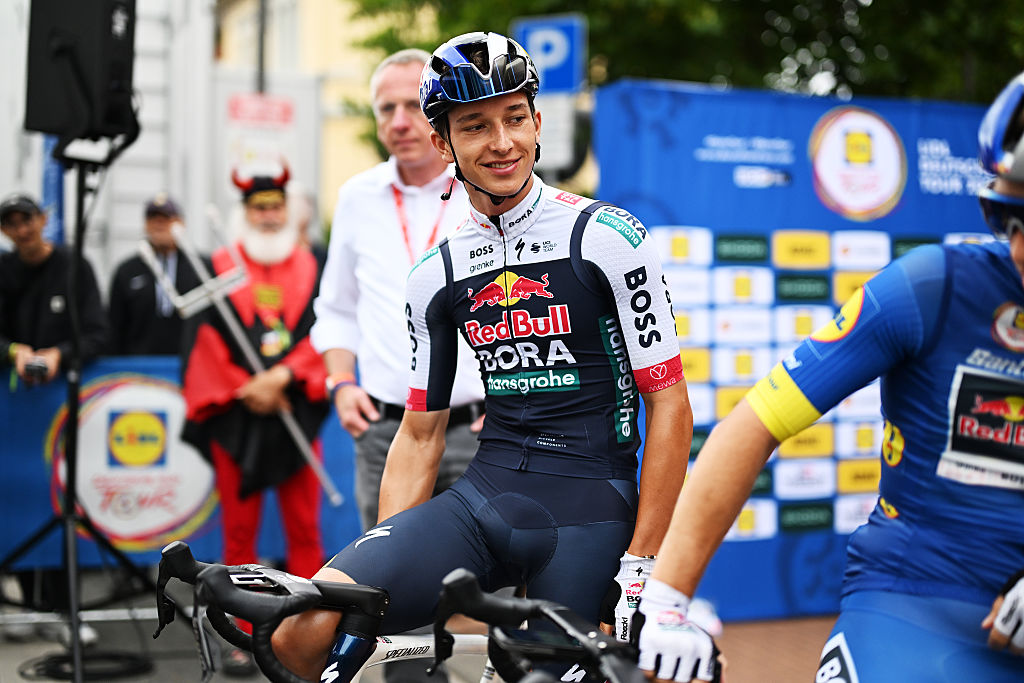Cyclingnews Verdict
Pros
- +
Good value for money
- +
Solid spec choices
- +
Effective, maintenance-free fork
- +
Monster tyre clearance
- +
Very user-friendly frame details
Cons
- -
Fork aesthetics may be off-putting for some
- -
Moto brake cabling could lead to cable rub
You can trust Cyclingnews
- Price: $6,890 (approx. £5,100)
- Weight: 8.59kg
- Sizes: XS-XL
- Groupset: SRAM Red AXS XPLR
- Colours: Obsidian black, Basalt black, glacial white, Sifra blue, Moss green
The Seigla, pronounced Say-gla, is Icelandic brand Lauf’s gravel bike. If you aren't familiar with the bike or brand, yes, it's the one with that mad-looking fork.
It’s available in rigid and suspension fork-equipped models and replaced the brand's previous gravel machine, the True Grit.
Lauf is an Icelandic brand with a direct-to-consumer business model. The carbon fibre manufacturing is done in China, and bikes are assembled in Virginia in the US and then shipped to customers.
The word Seigla itself is an Icelandic word meaning persistence. Lauf means leaf, If you were wondering about the names, regarding the leaf-sprung suspension fork.
The Seigla, in its non-rigid form, is fitted with the easily recognisable Lauf Grit front suspension fork, which uses a unique design and leaf spring suspension system to add compliance, which we will get into further on.
The Seigla is not a new bike and has become well known amongst the best gravel bikes thanks to its large tyre clearance and the Grit suspension fork with its unique silhouette, which has probably benefited from riders like Dylan Johnson using it, a gravel racer famous for his progressive gravel bike setups.
Those are the standouts or calling cards of the Seigla, but to focus on those two headlines alone would be to do the bike a disservice.
The latest race content, interviews, features, reviews and expert buying guides, direct to your inbox!
The Seigla is available as a frameset with a Grit fork or in six different build specs, which range from $3,350 for the Seigla Core Transmission model and rise up to the Seigla Ultimate at $6,890, which is the model I have been testing for the last few months, hot off the back of the Traka, where I rode the new Canyon Grail, also equipped with a suspension fork.
I also arranged a chat with the CEO and founder of Lauf, Benedikt Skulason, to learn more about the brand and the design features of that interesting-looking fork. I’ve included some of that chat within this review.
A big part of the Lauf philosophy and its approach to the gravel bike can be summed up with the phrase ‘smooth is fast’. Lauf is all about smoothing the rough stuff out so riders can go faster and stay fresher.
The tyres, Grit fork and a few other details at the front of the bike are all aimed at damping out off-road buzz and chatter and providing a smoother, more comfortable and hopefully faster ride.
Lauf has been ahead of the curve for some years regarding tyre clearance in particular, as well as reducing vibrational losses and increasing rider comfort to minimise fatigue. This is the opposite of the thinking that a harsh-feeling bike will be fast, which has prevailed basically since the dawn of time.
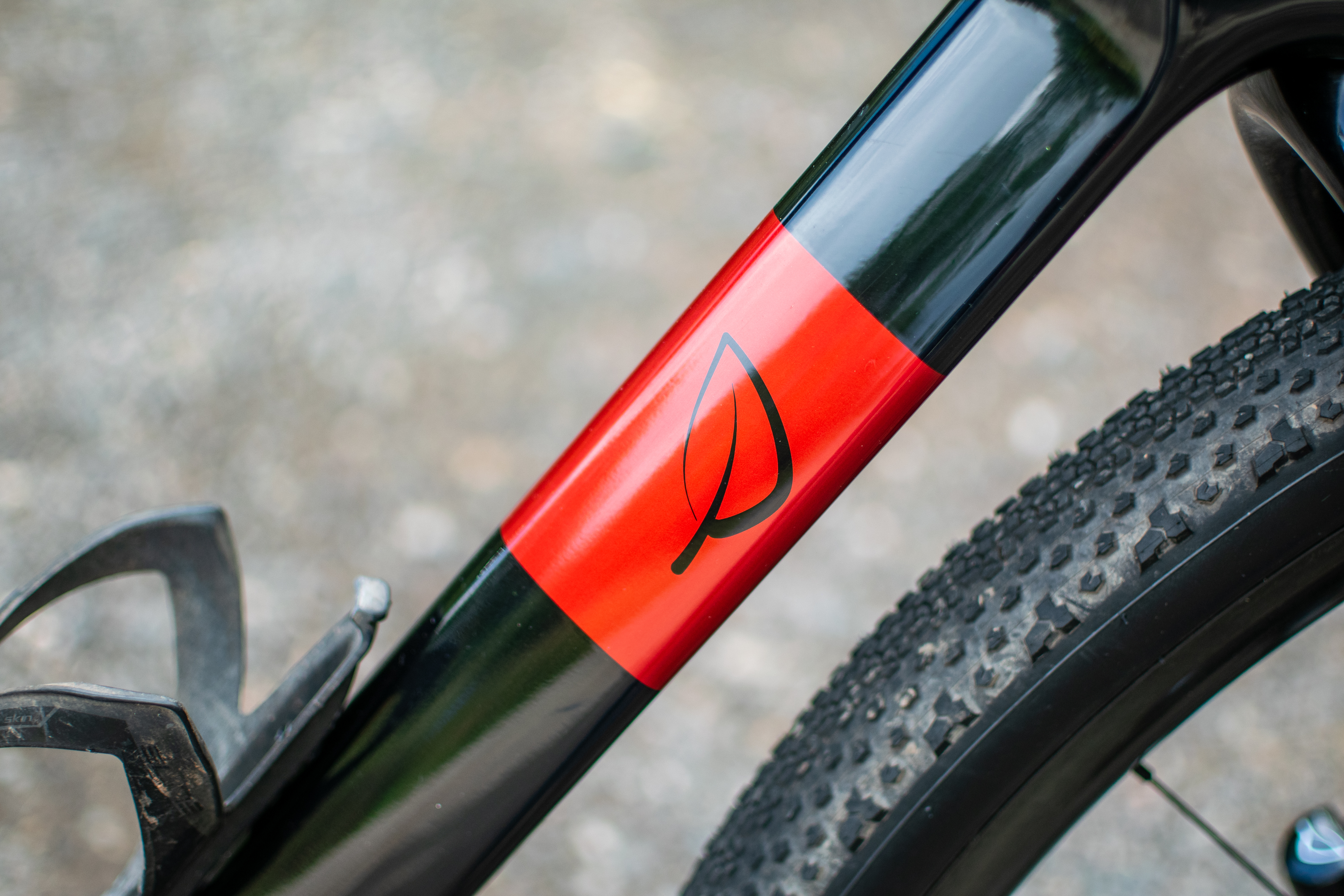
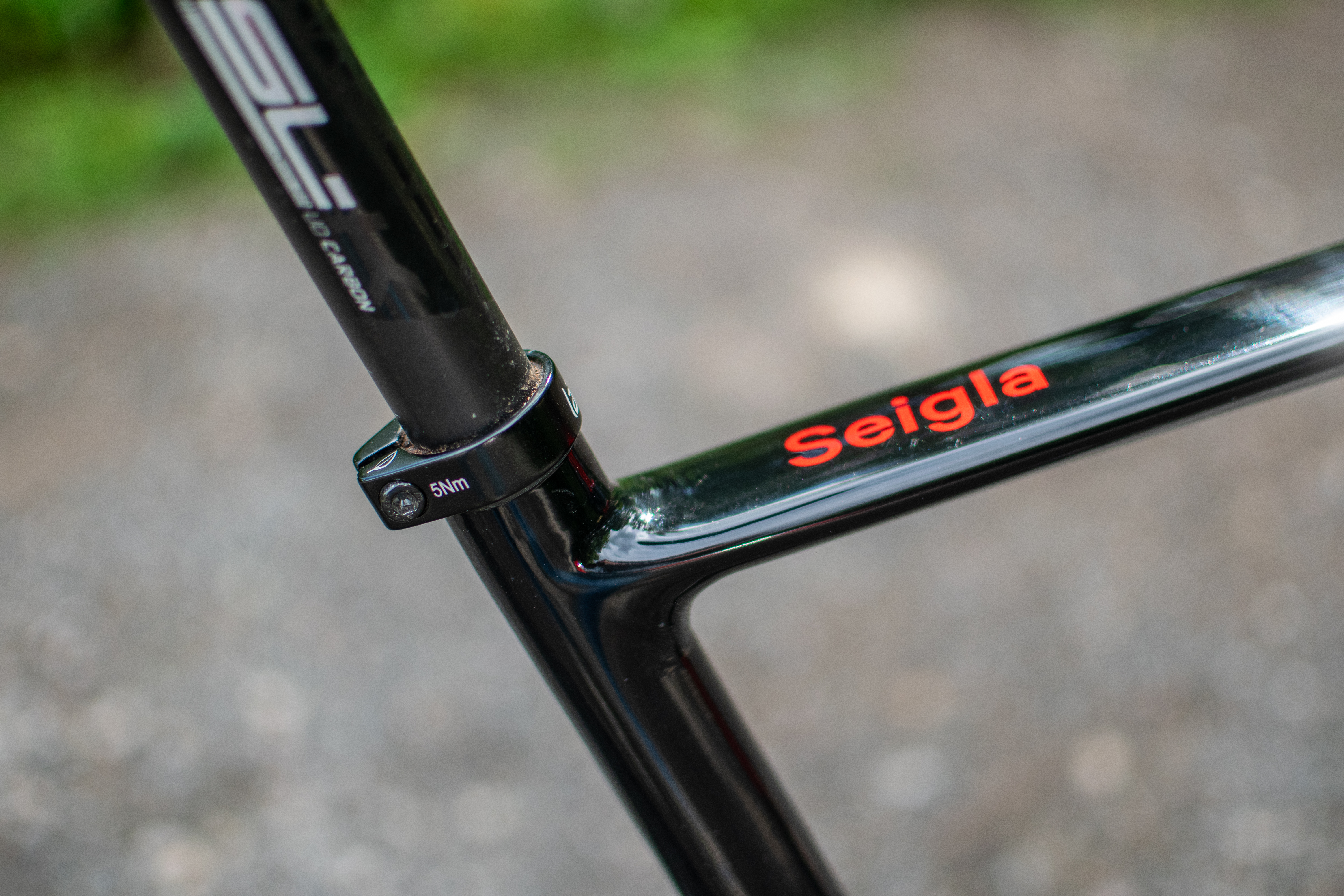
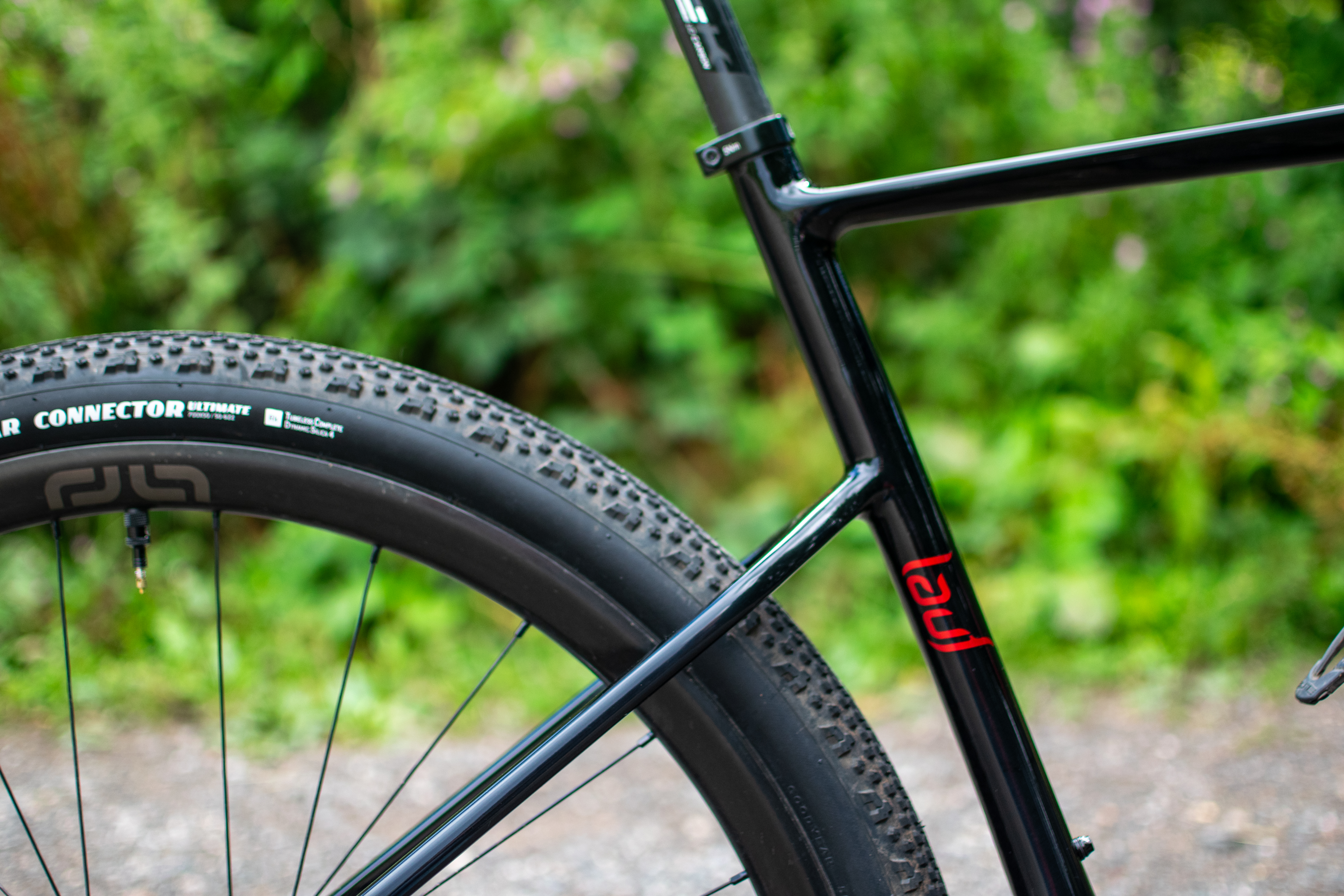
Design and aesthetics
My Ultimate model bike arrived in the Obsidian black/glossy colourway, and the glossy black and red paint looks great out of the box. I have seen lighter Lauf paint jobs, but I think the darker colours work better for the frame and, in particular, the fork, but it is of course down to personal preference. The branding is fairly subtle. There are a few logos and wordmarks here and there, but the branding is pretty clean and unassuming overall. I like it.
The Ultimate, as the model name suggests, has a big spec. There aren’t any chinks in the armour, which, as you will read, is a recurring theme with this bike.
There’s the carbon fibre Lauf frame and 3rd gen Grit fork, SRAM Red AXS XPLR 1x13 groupset with dual power meter, which is as good as it gets off-road right now, and a pair of E13 Piedmont Race carbon fibre gravel wheels.
Rounding things out are Goodyear Connector 50mm tyres, which are standard across all models. There's a Lauf smoothie carbon/glass fibre handlebar, which is aimed at damping out front-end vibrations, FSA V drive stem, FSA SL-K round zero setback 27.2mm seatpost and topped off with a Fizik Aliante saddle.
Interestingly, every bike in the line is fitted with an FSA Honey upper headset bearing. Developed with Lauf; this ‘damped’ upper bearing is designed to stabilise and calm the steering as well as smooth vibrations. No, a single bearing isn't going to magically get rid of vibration; it's more about how it changes the steering feel at the bars.
It’s noticeable when you pick the front end up off the floor and turn the bars, things feel a bit smoother and slower. Turning the bearing race in your hand, the bearing feels smooth but very 'slow' for want of a better word. It can also be retrofitted to any Lauf bike, and there’s a lower bearing option as well if you want to double up the effect.
General bike assembly is easy out of the box, but the headset preload instructions are specific to get the bearing settled down, so follow the Lauf guidelines here.
On the topic of guidelines, the Lauf website probably contains the most information I’ve ever seen from a bike manufacturer. Lauf has answered just about every technical question you might have on the Seigla clearly on site, and there’s also a very informative set of videos on the Grit fork design. I was impressed, and it tells me the brand cares about giving customers as much information as they can.
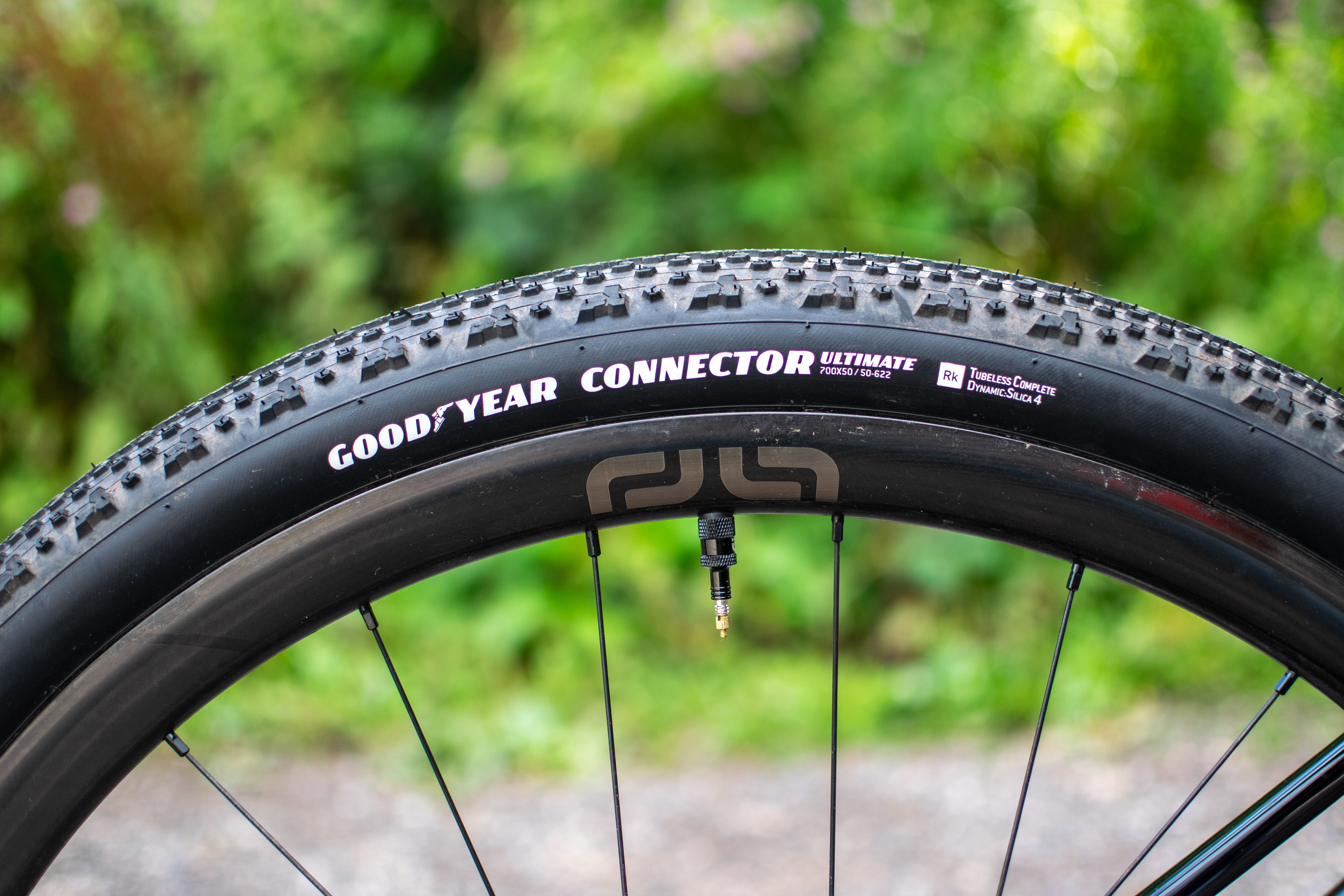
The Seigla frame itself uses a mix of tube shapes and profiles. A traditional round headtube transitions into a deepened rear section, which leads to a flattened top tube and triangular down tube. There are dropped seastays at the rear, a huge bottom bracket area and a SRAM UDH full mount dropout at the rear.
There are also big tyre clearances here, some of the biggest around for a gravel bike. The Seigla can accommodate up to 57mm tyres or 2.25” 29er tyres, like the Allied Able, my colleague Josh recently tested. I have some big old 2.2” Continental mtb tyres to fit and try out next.
The large rear tyre clearance is achieved in part by using a solid section of straight rear driveside chainstay between the chainring and tyre. This allows for a smaller tube to be used to maximise clearance.
There are bosses on the top tube for a bag, a pair of water bottle mounts in the main frame triangle in the normal places and an extra pair under the down tube. There aren’t mudguard mounts, but you could of course fit clip-on fenders, which would probably be a better fit functionally and visually anyway, if a less solid option.
Some nice spec points minimise potential hassle. Rejoice, the frame uses a standard round seatpost clamp and a 27.2mm standard round seatpost. The non-integrated round bar and standard stem also mean you can easily adjust or swap things, and the brake hoses are routed externally outside the handlebar. This also means headset servicing is easy, and you won’t be hit with big bills at the bike shop for this.
The cabling is semi-internal, another tick in the easy-to-live-with box. The front hose runs completely externally outside the Grit fork. OK, it's in part due to the fork design, but it's almost unheard of now for a top gravel bike.
The rear enters at the head tube, and runs through the down tube and exits at the start of the non-drive chainstay.
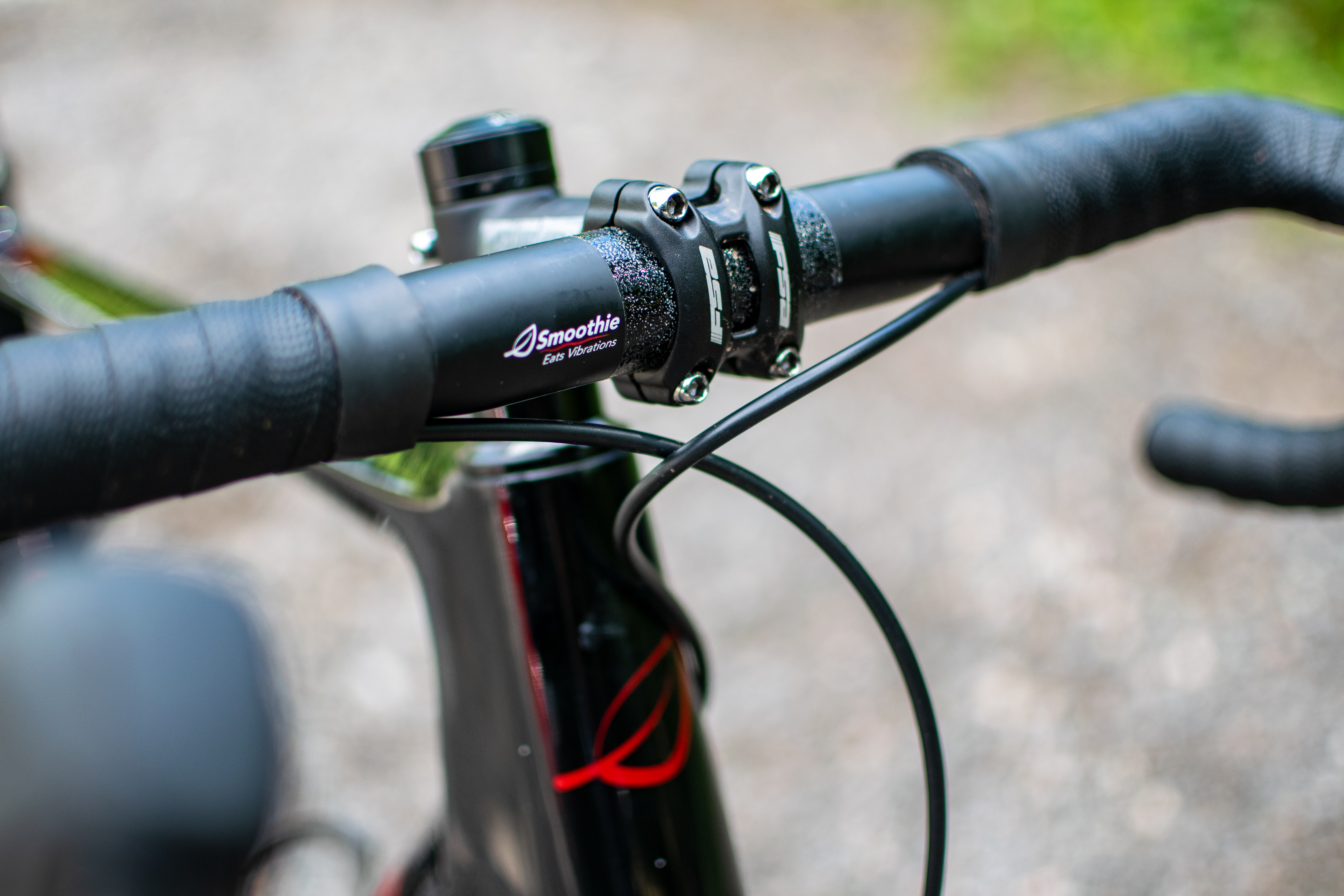
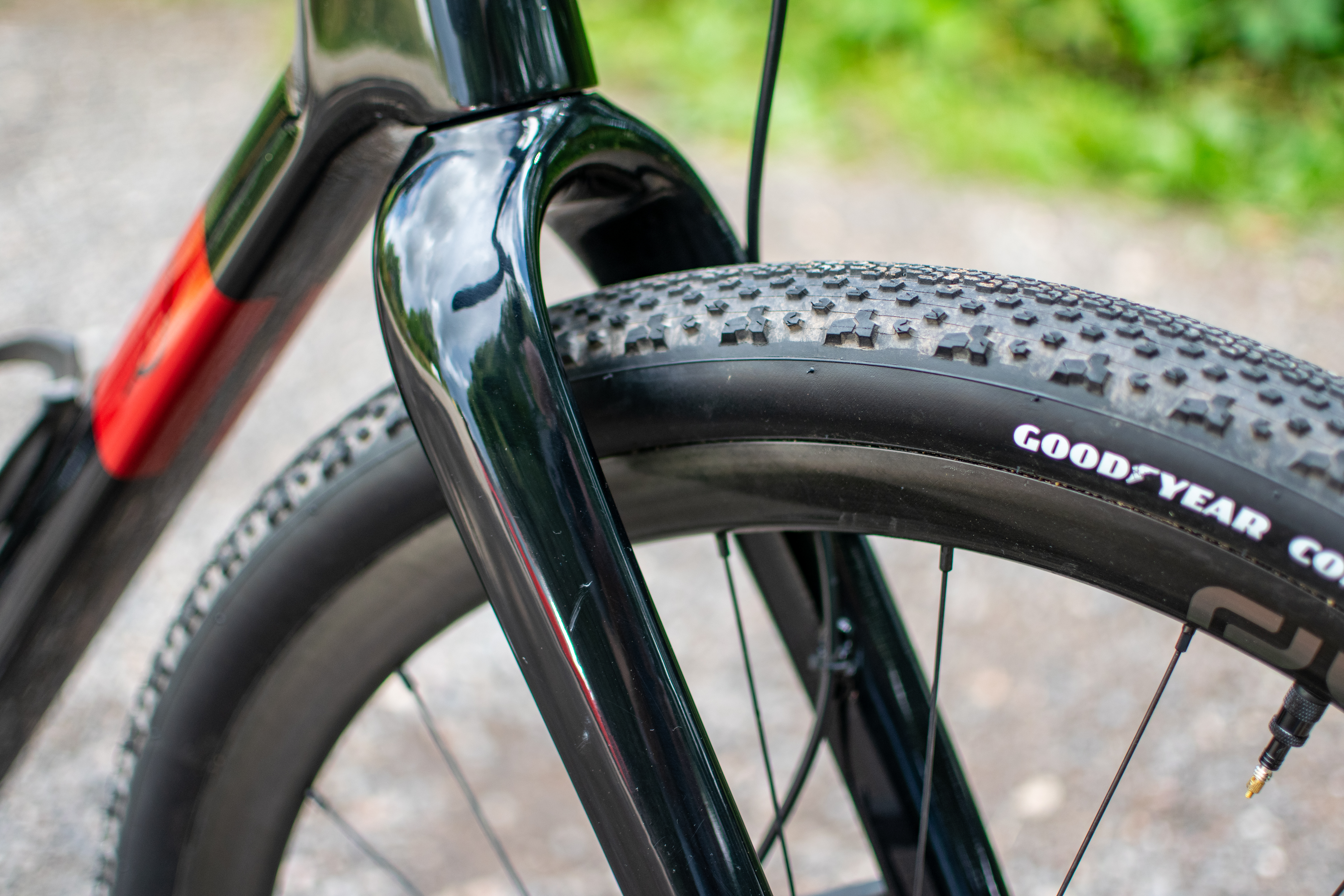
I’ve been riding a medium-sized frame. Lauf describes the bike's geometry as providing a 'fast but comfortable fit' optimised for weekend warriors and racers alike.
How do you marry those fairly different requirements? With a short headtube and 35mm of spacers as standard on each bike. The racers can slam things if required, and 35mm of spacers should be enough for most.
Here are some top-line geometry numbers. The M Siegla has a wheelbase of 1040mm, a stack of 564mm and a reach of 394mm. The fork rake is 47mm, and the headtube angle is 70.5 degrees.
A medium Seigla has the same reach number of 394mm as the size small Canyon Grail CF SLX I reviewed earlier in the year.
That bike was a better fit for me than Canyon's medium, but the medium Lauf I've been riding here is 9mm lower than the Grail, 6mm longer, and 1 degree slacker at the head tube to give you an idea about how it shapes up alongside the Grail, which is a popular Gravel bike generally.
It does indeed feel tuneable, yes, every bike is, but you can go either way here. It's slightly slacker and longer than the Grail, a popular and proven bike for gravel racing, yet, with the in-line seatpost and lower head tube, you could slam it or make the fit more aggressive. Fit narrower or aero handlebars and things would start to look and feel pretty racey.
For me, an amateur tackling a range of gravel riding. A standard setup with some spacers under the bar has been fine, but I can still take an aero position on the hoods and get cracking on the road, in part thanks to the Smoothie handlebars' 80mm reach.
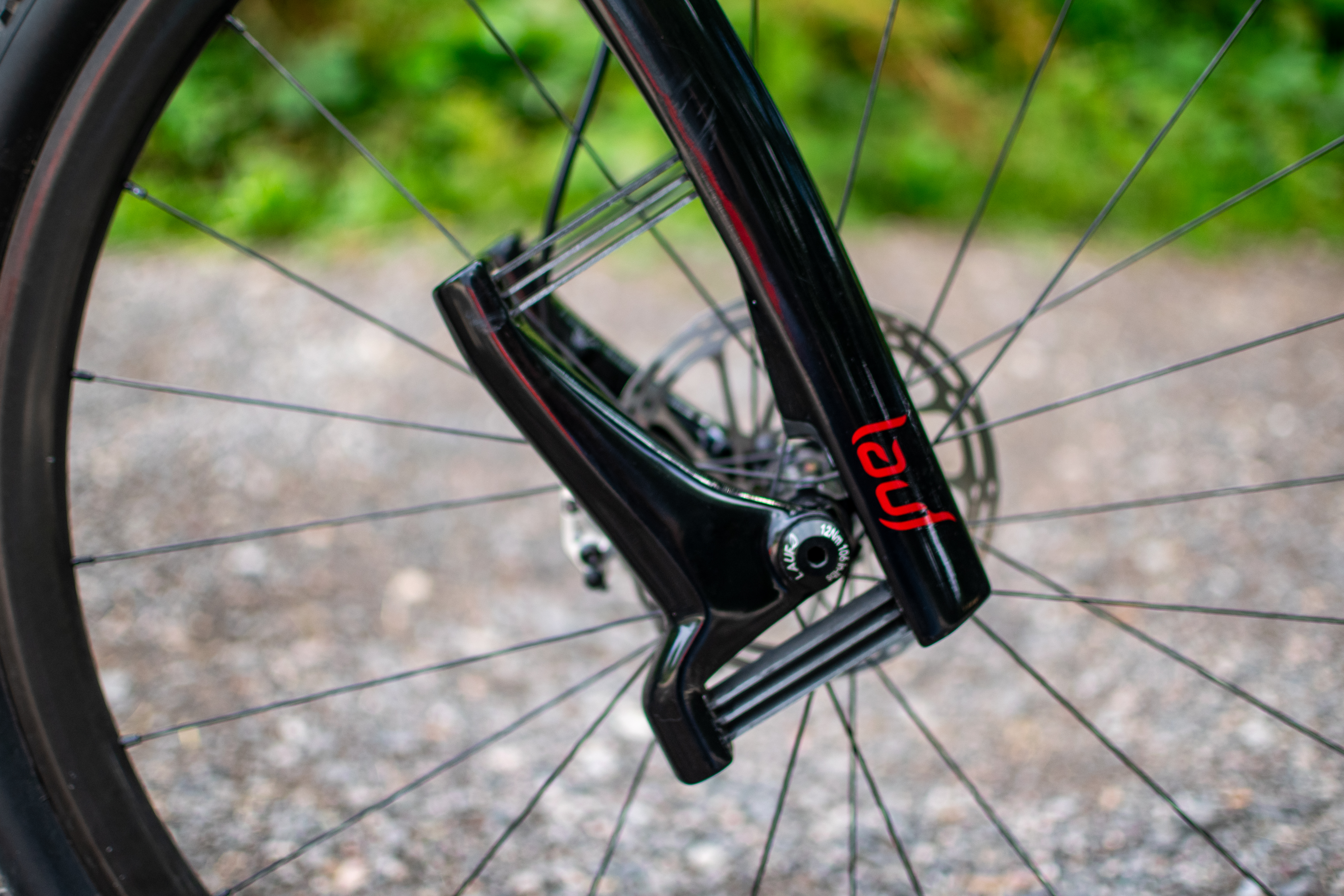
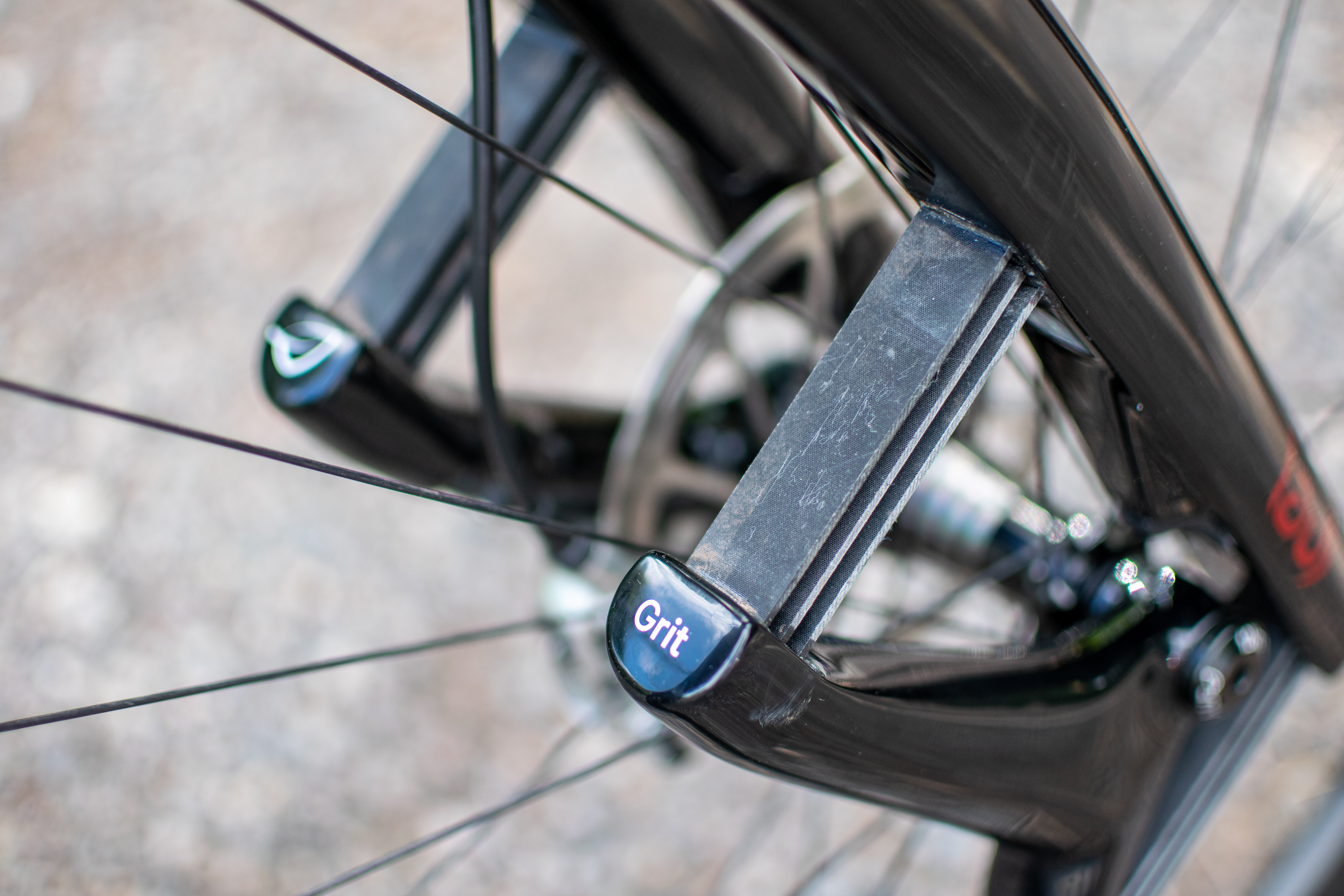
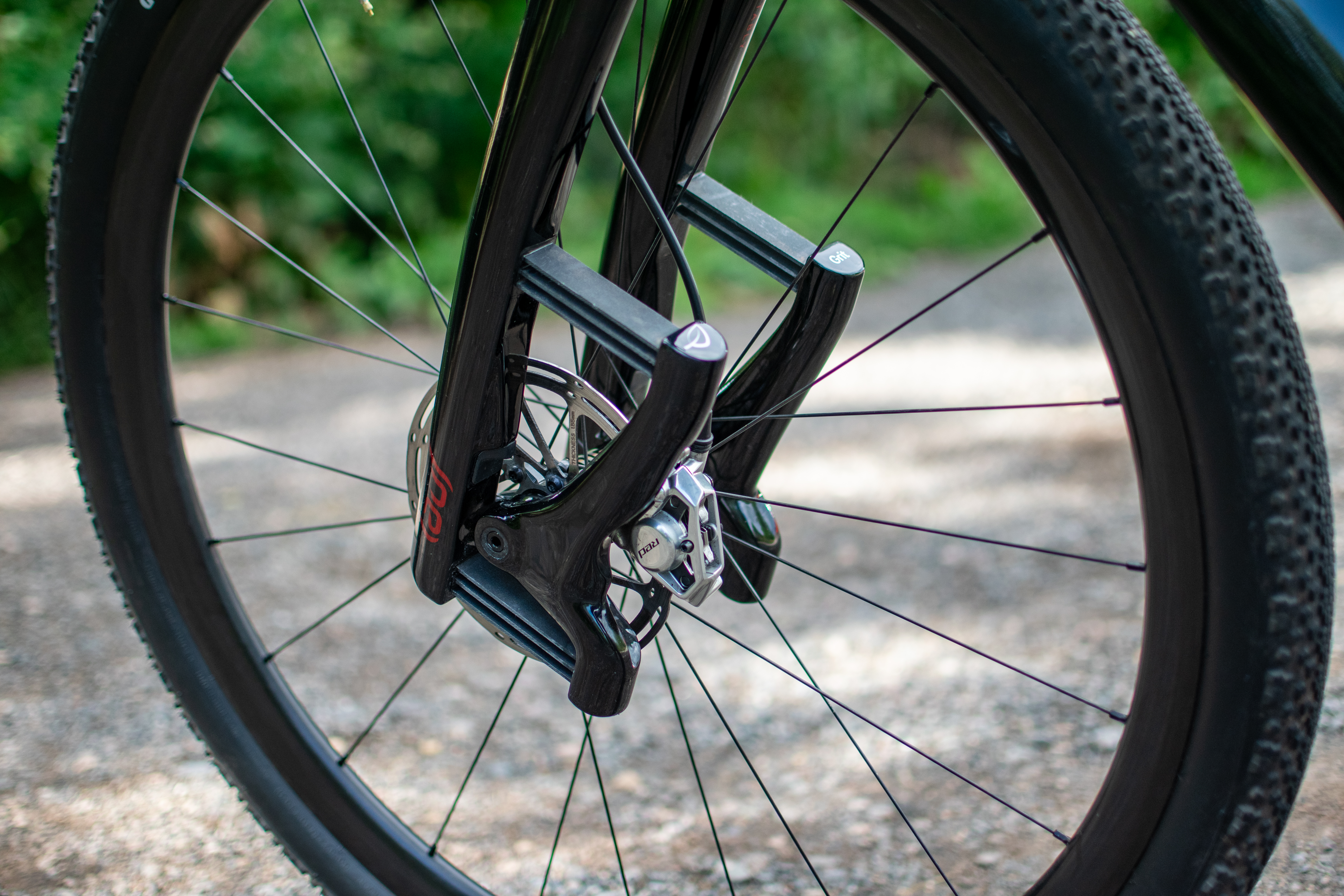
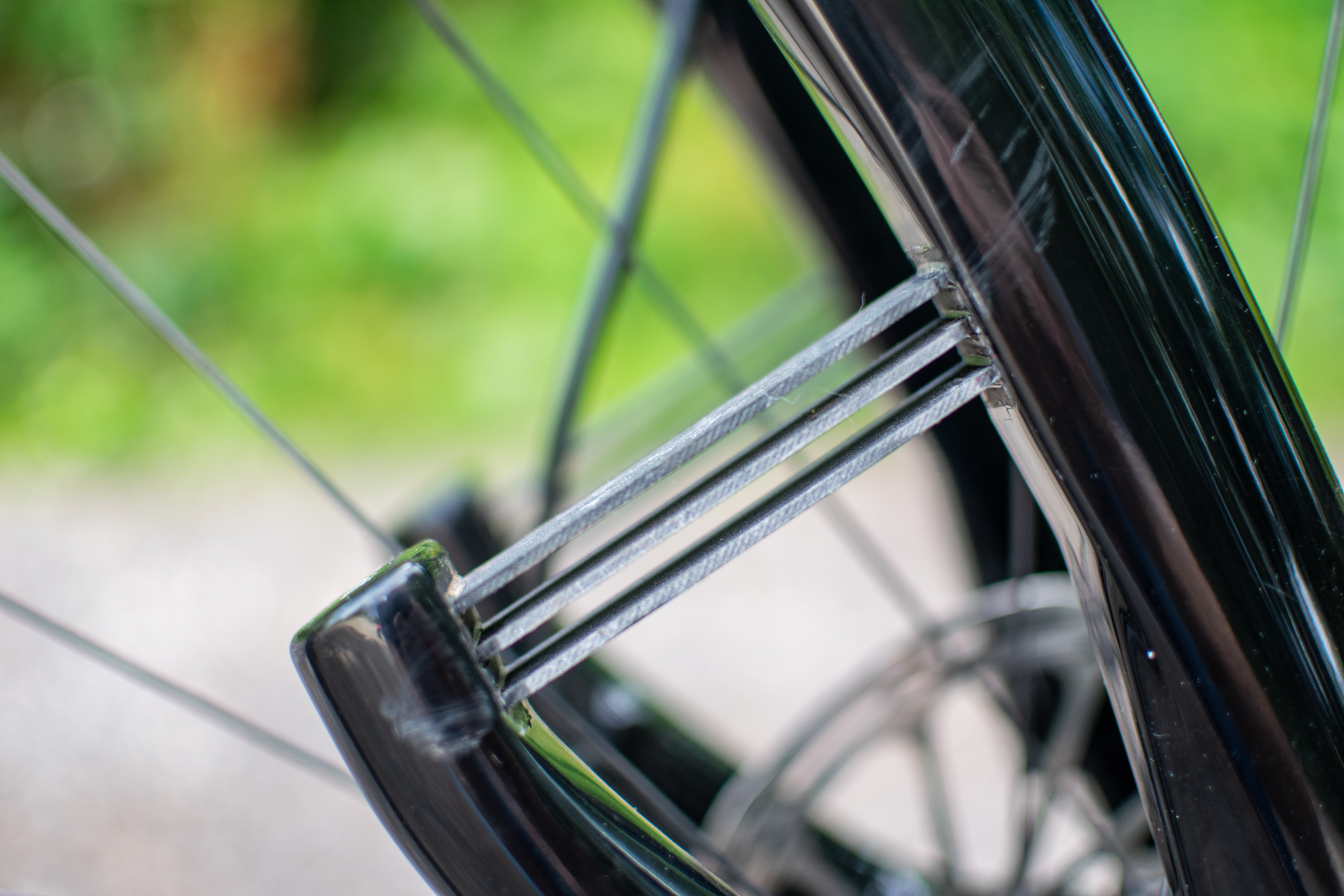
Now, about that fork. Lauf's founder and the designer of the Grit fork, Skulason, knew he wanted a suspension fork to add compliance at the front of the bike. For Skulason, using composites was the way to go thanks to an existing passion, and the leaf-sprung Grit fork, now in its 3rd iteration, was the result.
A leaf spring, probably more common in the automotive world, is a 'spring built from narrow, flat blades which resist load in bending' to quote the Collins dictionary.
The leaf springs in the case of the carbon fibre Grit fork are comprised of four separate stacks of individual glass fibre leaf springs. There are two stacks on each side to ensure the correct level of torsional stiffness is maintained for the fork. Each spring is made from 16 layers of S2 Class glass fibre, a high-performance glass fibre variant.
"It's almost on a par with carbon fibre for strength, but there's triple the flexibility", Skulason explained.
The springs sit into 'pockets' in each fork leg, which, granted, are a bit burler than the average rigid one. These pockets are about 14mm deep. Each spring is then epoxied into place, and afterwards an aluminium pin is also bonded in via a drilled hole to further strengthen the bond. In short, the leaf springs in the fork aren't going anywhere, which is a point I was keen to ask about.
The fork, thanks to the springs, provides 30mm of travel and becomes stiffer the deeper into the travel you go. So hopefully the fork never bottoms out, but it's nice and sensitive over finer surfaces. It's also stiffness-tuned to each frame size, which is achieved by changing the angle of the fibres in each spring.
Another big plus point is that the fork requires zero maintenance, ever. Surely an advantage over gravel bikes with suspension forks like the YT Szepter I tested a while back. The sliding nature of conventional suspension forks requires maintenance, as Skulason explained
"You don't have to add friction anywhere. Friction is bad for various things. It eats up energy, and it requires maintenance. As soon as you have something slipping on something, then you have to maintain it."
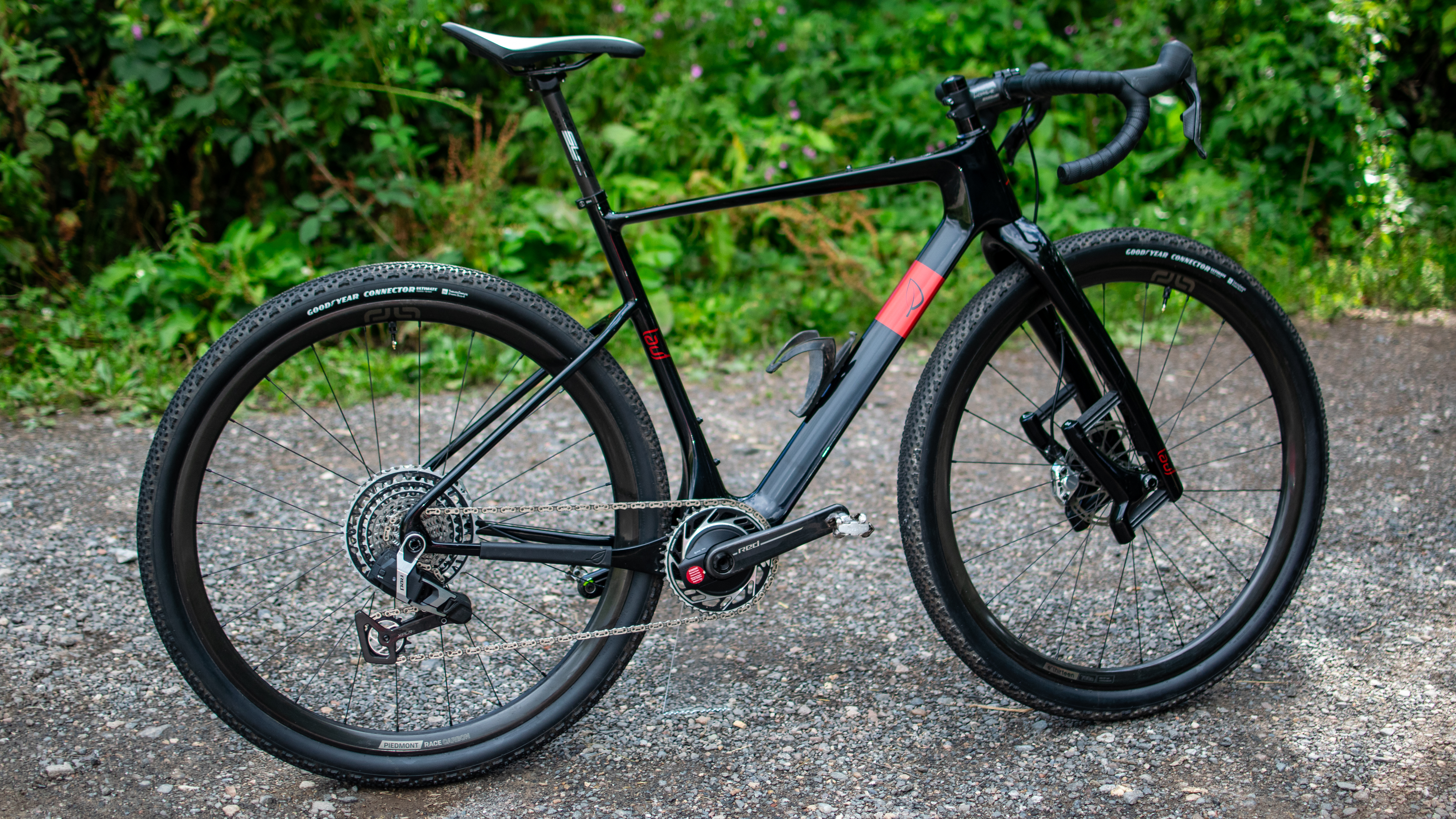
Performance
The Seigla hasn't put a foot wrong during my test period. I've had zero issues with the frame, fork or any of the components. The frame and hardware finishing is very good across the board, and I haven't come across any subpar elements.
The Red XPLR groupset is, as mentioned, as good as it gets off-road currently; you don't have to think, and the brakes are fantastic. The trickledown of tech to Force and Rival groups now should also benefit other models.
Tubeless setups have also been easy on the E13 Piedmont wheels. I swapped in the Schwalbe G One AllRounds in a 45mm size for a while, and I did everything with a track pump.
The Seigla really is super smooth off-road on gravel surfaces. Imagine a sliding scale of the vibrations and feedback you feel through a gravel bike's handlebars and contact points – a rigid gravel bike and a range of tyre/pressure combinations will iron out some, and a suspension fork-equipped gravel bike is capable of taking some more out again.
The Seigla, however, eliminates another even finer layer of vibration and chatter, particularly on fine to medium gravel surfaces that would be difficult to get rid of with any other platform that I know of. Throw in the 50mm tyres, and the ride is similar to how a road bike being ridden over rougher tarmac feels at times, but off-road.
Now that I have ridden the Grit fork, it's easy to get on board with the argument for it. You don't need to touch it, ever, apart from cleaning the thing. The fine bump sensitivity is really very nice, and it doesn't dive as much as a suspension fork on tarmac when out of the saddle. Hit something bigger and it firms up. I don't think I've gotten close to bottoming it out.
For gravel, not mountain biking, I can't help but feel it has the edge over a gravel suspension fork, and the fact that it can be constructed from carbon and glass fibre means there is less of a weight penalty than a metal fork.
The bike feels capable and comfortable across the board, very stable at speed on fast descents, and nimble in more technical sections. It's done well everywhere, and I've been comfortable while doing it.
The bike doesn't handle like a super tanker either; it's not long, sluggish and boring. It's exciting and nimble to ride, it's just super smooth with it.
What I like about the Seigla is that it isn't some hyper-specialist, crazy gravel bike that's only right for a small slice of people who are off into the wild at every chance on a mad bikepacking trip or racing the Lifetime Grand Prix series. I think, at face value, people might look at the fork, see a slightly unfamiliar name and think, no, that's not right or too much bike for me.
The Seigla is a very user-friendly, super comfortable bike that will look after anybody off-road. You will be more comfortable, confident and poised on this bike thanks to what it brings to the table.
Conversely, with some changes you could really optimise the platform for straight-line gravel speed, which is a big part of competitive gravel racing now. With narrower bars, a more aggressive front end and the right wheel and tyre combo you would be looking at a seriously quick bike off-road for racing.
I also love the fact that you have some wiggle room with the standard spec components to change them out easily to suit and start dropping weight, something I miss a little on modern bikes with their proprietary components. Ok, you can do it, but it's damn expensive.
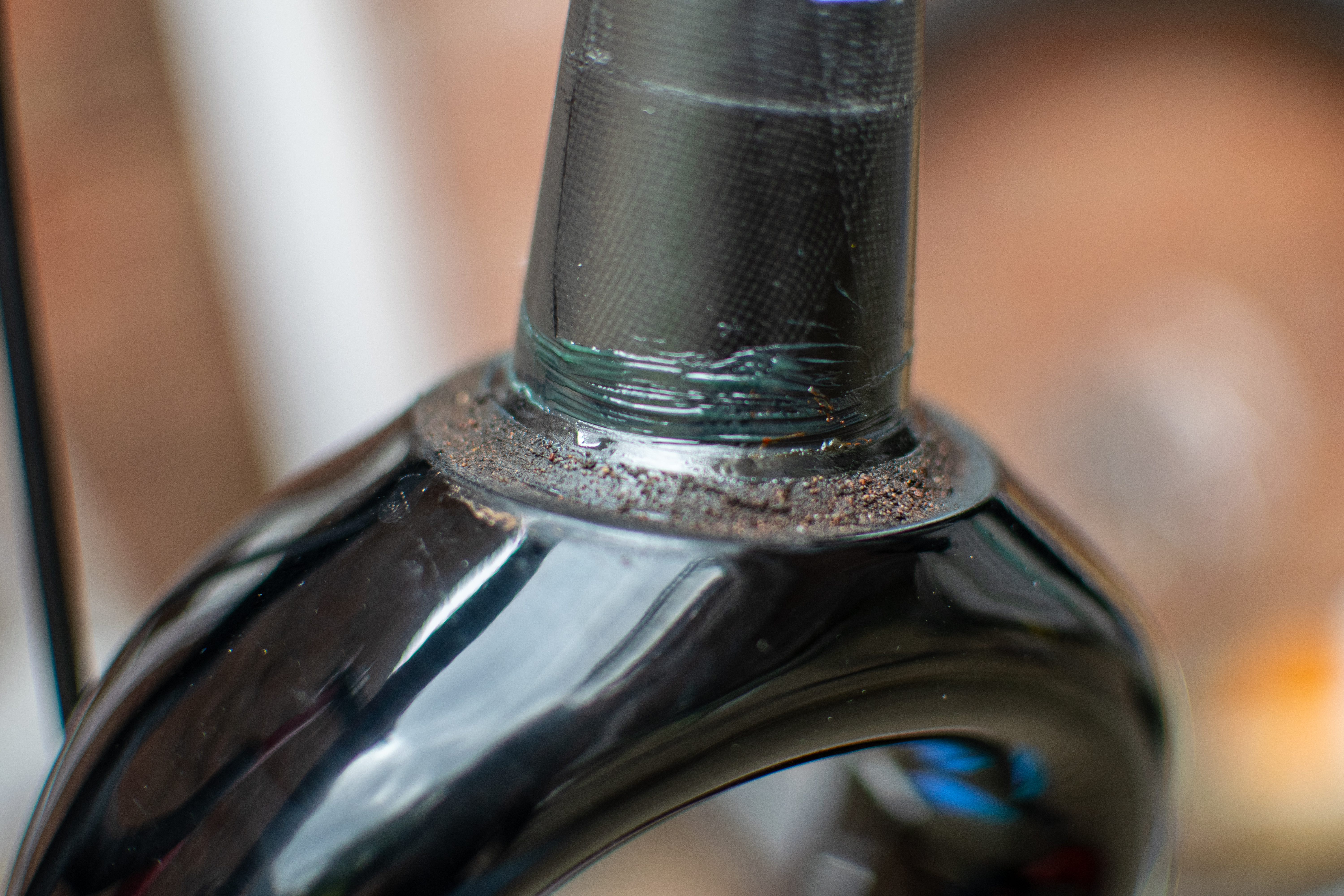
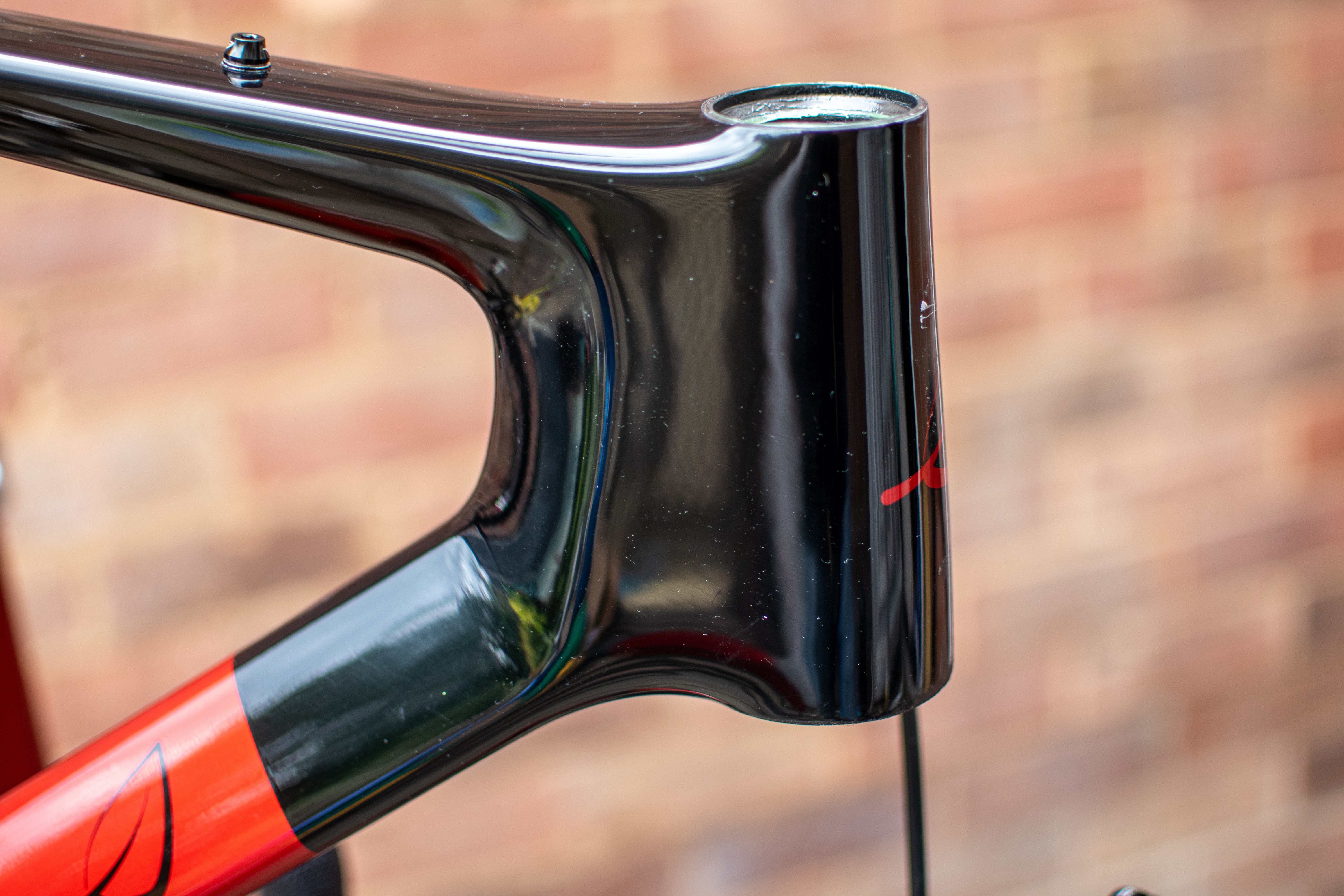
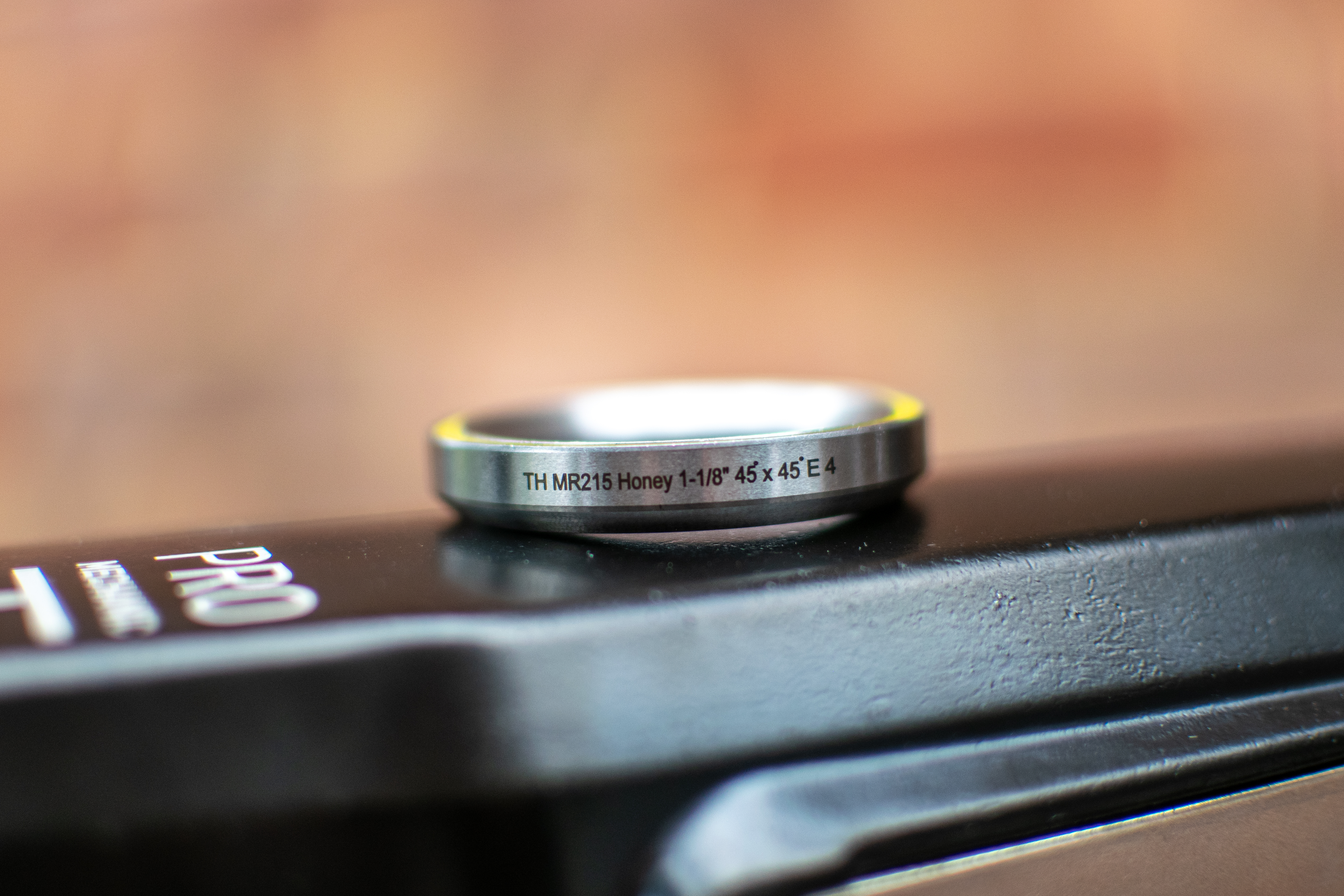
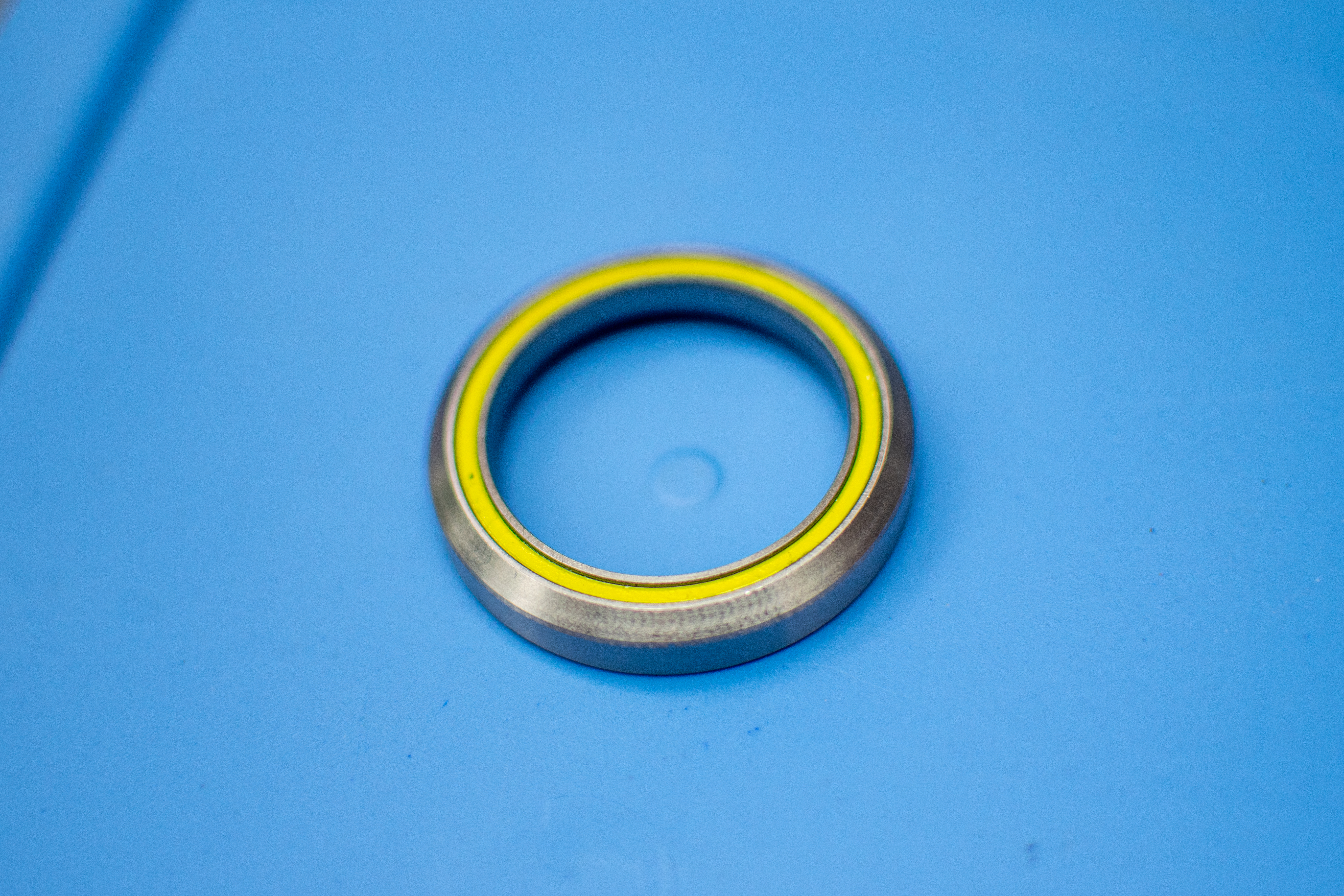
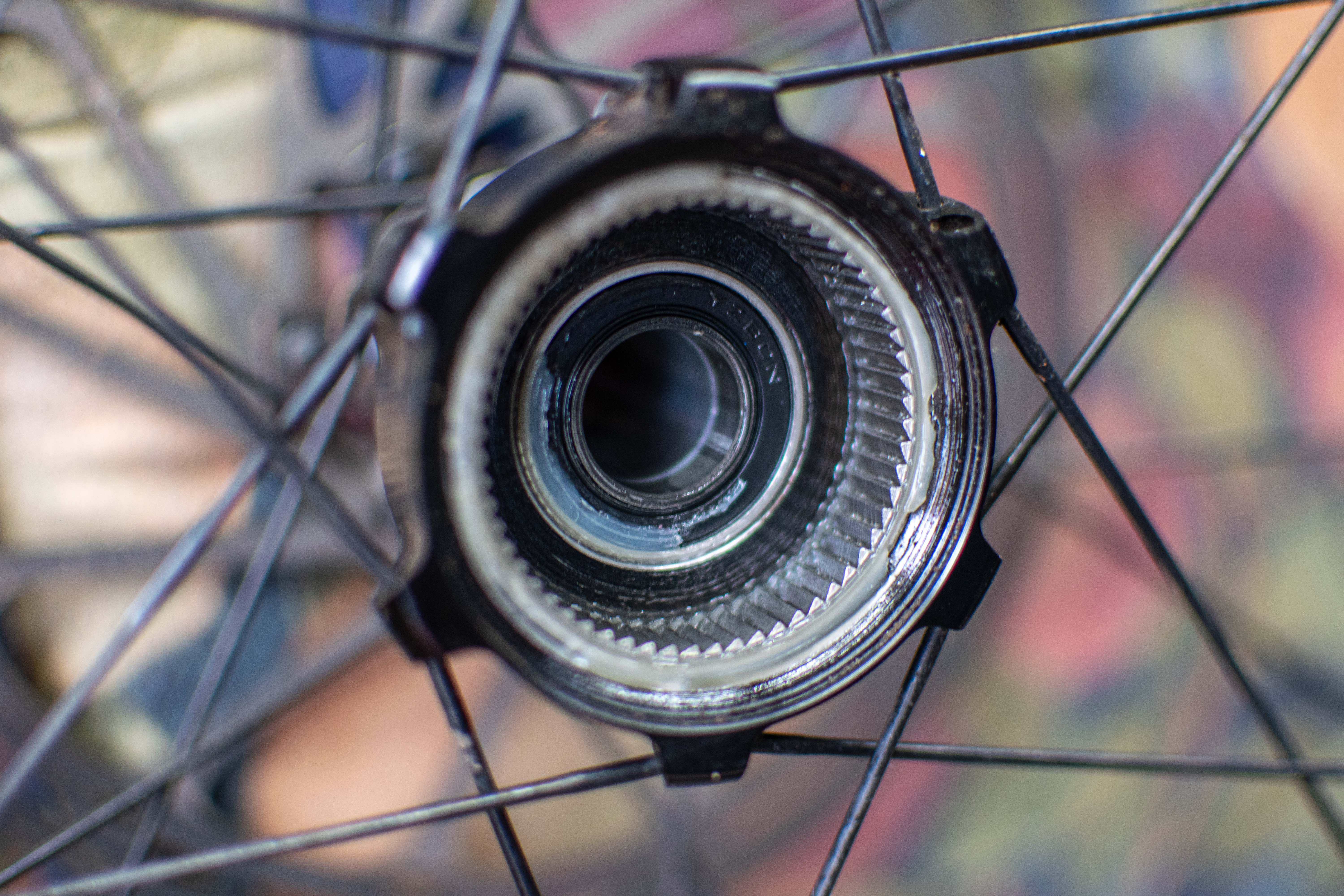
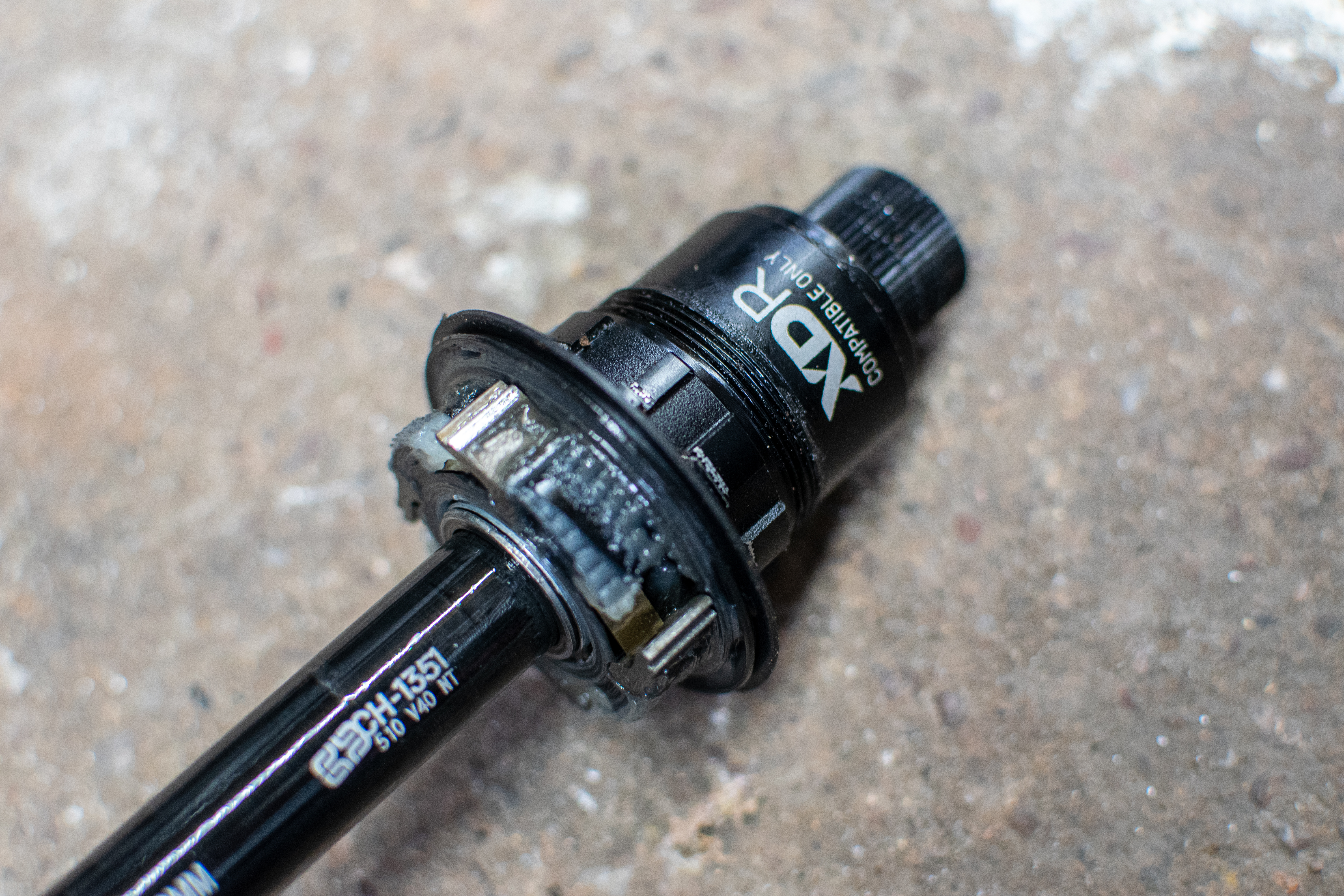
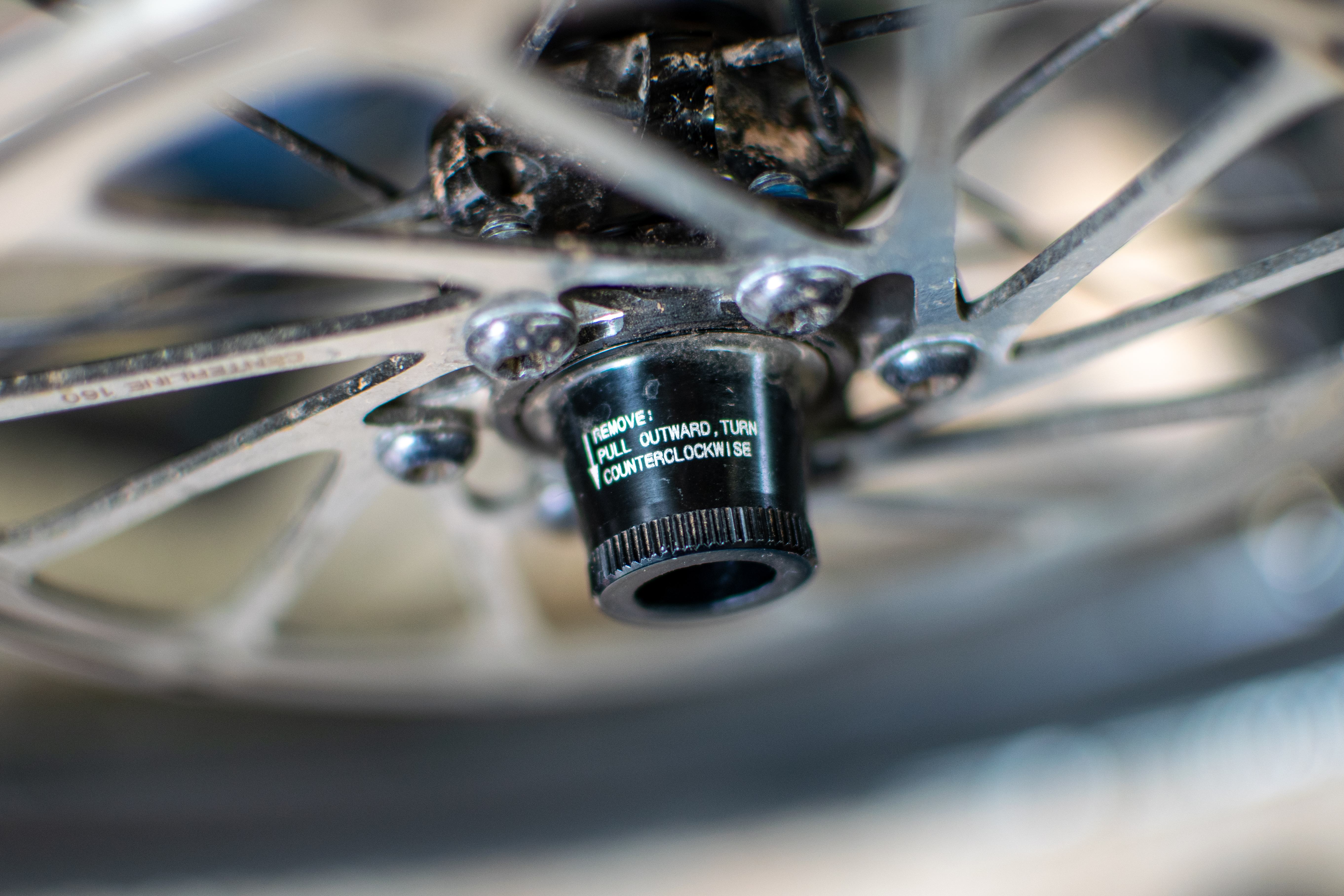
Maintenance and servicing
If you invest in a Seigla, you won't need to worry about any of the bigger servicing bills associated with complex, integrated front ends that often occur these days.
Maintenance and servicing should be pretty easy on the bike. In terms of routine service jobs like hubs, bottom brackets and headsets, you stand to save money and or time if you do it yourself compared to bikes with a fully integrated front end.
I dropped the forks out to service the headset, and it only took me a couple of minutes. With the round bar and standard stem and external front brake hose it’s very simple to do, and it reminded me of simpler times gone by. Headset maintenance will be very easy and cheaper than the majority of high-end gravel bikes with more complex front ends if you're riding in the slop all winter.
The bottom bracket is threaded; it’s a user-friendly platform and requires simpler tools, no problems there.
The E13 hub end caps on my model pull off easily without tools, meaning you can at least wipe the bearings clean externally and apply fresh grease in between full services. The freehub body and rear axle can also be removed in seconds without tools, meaning you can clean and re-grease the pawls easily if you so wish.
A round seatpost and clamp need little introduction, but they again make things that little bit easier to do.
I would also recommend keeping the SRAM full mount UDH ‘sleeve’ clean and dirt-free long term. It’s a simple job to do.
All told, it will give a mechanic a very easy life, and if you like to do work at home, there isn’t much that should catch you out or cause headaches. Perfect for a bike that may be destined to take a fair bit of abuse.
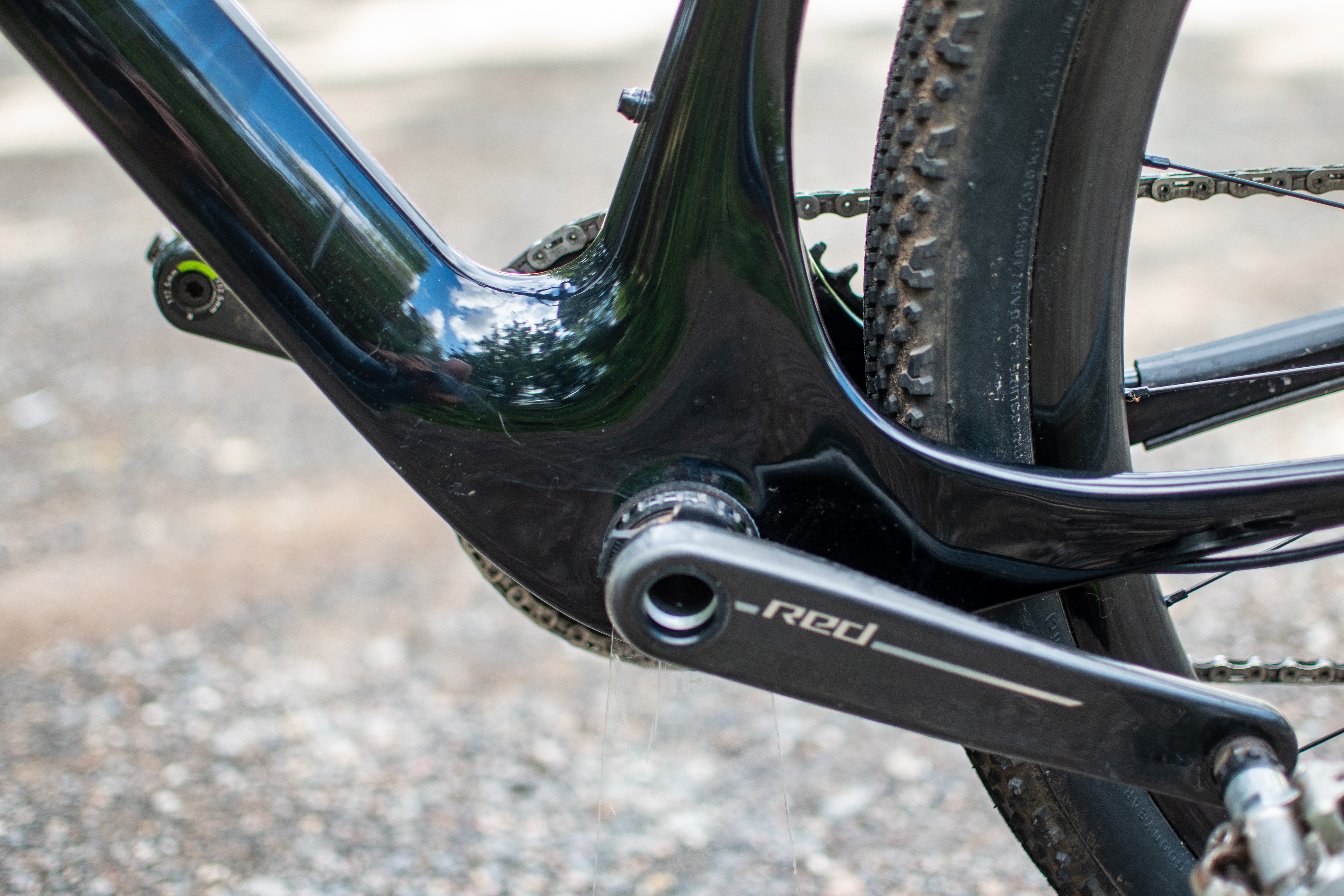
Value
Bikes are expensive. I think this is a good value one, for the money.
This bike can be yours for $6,890, which is still a big chunk of cash, but I think it's money well spent.
A competitor worth mentioning if large tyre clearance is a priority for you is the 3T Extrema Italia, one of the few gravel bikes with 57mm clearance, the same as the Seigla right now. The cheapest model in that range comes in at $9,299, and you're looking at $12,799 for a Red XPLR-equipped model.
Likewise, if you want the Red XPLR-equipped Allied Able gravel bike, another option with 57mm clearance, you're looking at $11,500. That's a big chunk more than our Seigla.
So, for a Red XPRL spec bike with big clearance, the Seigla is out front alone. You won't see this groupset on many bikes under $7k in any currency.
But what about everything else? I can't see a chink in the armour of my bike spec and think it's very competitively priced for the money overall.
I also think the fact that every model in the range has the same spec frame, fork and tyres, and even the FSA Honey headset bearing speaks volumes. This shows Lauf has put time into its pricing and range structure. Buy a cheaper model and you can always upgrade; you'll have the same frame and fork as the top fuel model I've been riding.
Verdict
I wouldn't be surprised to hear that Lauf is rather proud of the Seigla and Grit 3 fork. The frame and fork were ahead of the curve when they launched in 2022, and a handful of brands like Argon 18 and Ridley are just catching up now.
The Seigla has been excellent for me, and I suspect only when I go back to riding a rigid gravel bike will I fully realise just how smooth it has been. The Grit 3 fork performs excellently. It's a great design that takes compliance and off-road ride smoothing to a level I haven't quite felt anywhere else.
I admire the Lauf design choices, and they ultimately tell the story of a brand that seems to know what it is about and what it wants to create. Class-leading tyre clearances, capable geometry and an innovative, unique fork design coupled with a standard round bar and stem, external brake cabling and a standard seatpost clamp and 27.2mm post, now that's a combination I can really get behind.
Design and aesthetics | A good looking frame and there aren't any offensive components. The look of the fork may divide opinion, but I think it suits chunky tyres. The fork design itself is very clever. | 9/10 |
Build | Rock solid, top groupset and well chosen quality components everywhere else. Nothing i'm dying to change straight away. | 9/10 |
Performance | Excellent, exciting to ride, does everything well and the the fork and other features mean a super smooth, plush ride | 9/10 |
Weight | Very competitive at 8.59kg. Only 400 grams more than a Canyon Grail CF SLX. Lighter than a YT Szepter and just heavier than a size large top spec Allied Able. | 8/10 |
Value | I think this is a lot of bike for the money. The very light groupset in turn keeps weight down. Also easy maintenance and servicing will save cash. | 8/10 |
Overall rating | Row 5 - Cell 1 | 43/50 |

Tom joined the Cyclingnews team in late 2022 as a tech writer. Despite having a degree in English Literature he has spent his entire working life in the cycling industry in one form or another. He has over 10 years of experience as a qualified mechanic, with the last five years before joining Cyclingnews being spent running an independent workshop. This means he is just as happy tinkering away in the garage as he is out on the road bike, and he isn’t afraid to pull a bike apart or get hands-on with it when testing to really see what it’s made of.
He has ridden and raced bikes from an early age up to a national level on the road and track, and has ridden and competed in most disciplines. He has a keen eye for pro-team tech and enjoys spotting new or interesting components in the wild. During his time at Cyclingnews, Tom has already interviewed some of the sport's biggest names including Mathieu van der Poel, Tadej Pogačar and Alberto Contador. He's also covered various launches from brands such as Pinarello, Ridley, Specialized and more, tackled the Roubaix Challenge sportive aboard his own rim-brake Cannondale SuperSix Evo, tested over 20 aero helmets in the wind tunnel, and has created helpful in-depth buying advice relating to countless categories from torque wrenches to winter clothing.
You must confirm your public display name before commenting
Please logout and then login again, you will then be prompted to enter your display name.

